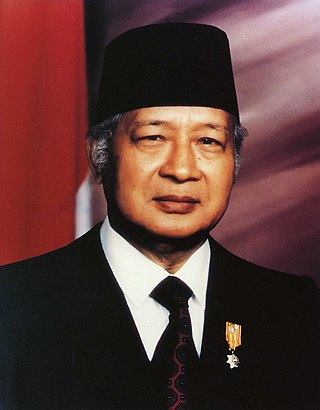
Suharto was an Indonesian military officer and politician, who served as the second and the longest serving president of Indonesia. Widely regarded as a military dictator by international observers, Suharto led Indonesia as an authoritarian regime from the fall of his predecessor Sukarno in 1967 until his resignation in 1998 following nationwide unrest. His 32-year dictatorship is considered one of the most brutal and corrupt of the 20th century.
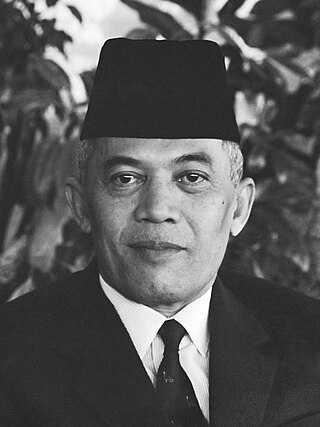
Abdul Haris Nasution was a high-ranking Indonesian general and politician. He served in the military during the Indonesian National Revolution and he remained in the military during the subsequent turmoil of the Parliamentary democracy and Guided Democracy. Following the fall of President Sukarno from power, he became the Speaker of the People's Consultative Assembly under President Suharto. Born into a Batak Muslim family, in the village of Hutapungkut, Dutch East Indies, he studied teaching and enrolled at a military academy in Bandung.

Adam Malik Batubara was an Indonesian politician, diplomat, and journalist, who served as the third vice president of Indonesia from 1978 until 1983, under President Suharto. Previously, he served in a number of diplomatic and governmental positions, including Speaker of the People's Consultative Assembly from 1977 to 1978, Speaker of the People's Representative Council from 1977 to 1978, Foreign Minister of Indonesia from 1966 until 1977, and president of the United Nations General Assembly from 1971 until 1972.

The term Government of the Republic of Indonesia can have a number of different meanings. At its widest, it can refer collectively to the three traditional branches of government – the executive branch, legislative branch and judicial branch. The term is also used colloquially to mean the executive and legislature together, as these are the branches of government responsible for day-to-day governance of the nation and lawmaking. At its narrowest, the term is used to refer to the executive branch in form of the Cabinet of Indonesia as this is the branch of government responsible for day-to-day governance.
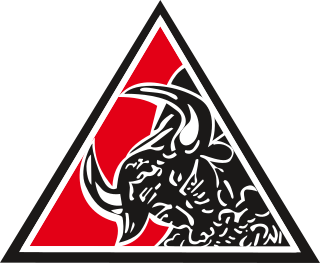
The Indonesian National Party was the name used by several nationalist political parties in Indonesia from 1927 until 1973. The first PNI was established by future President Sukarno. After independence, the new PNI supplied a number of prime ministers, and participated in the majority of cabinets in the 1950s and 1960s. The party was fused into the Indonesian Democratic Party in 1973. In the years following the reforms of the late 1990s, a number of parties claiming to be the continuation of previous PNIs stood in elections, but gained only a handful of seats.

The New Order describes the regime of the second Indonesian President Suharto from his rise to power in 1966 until his resignation in 1998. Suharto coined the term upon his accession and used it to contrast his presidency with that of his predecessor Sukarno.
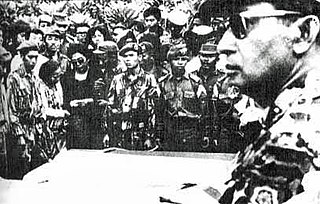
Indonesia's transition to the New Order in the mid-1960s ousted the country's first president, Sukarno, after 22 years in the position. One of the most tumultuous periods in the country's modern history, it was the commencement of Suharto's 31-year presidency.
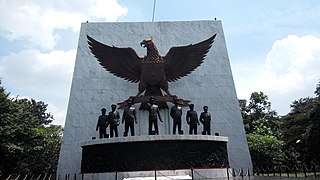
The Thirtieth of September Movement was a self-proclaimed organization of Indonesian National Armed Forces members. In the early hours of 1 October 1965, they assassinated six Indonesian Army generals in an abortive coup d'état. Later that morning, the organisation declared that it was in control of media and communication outlets and had taken President Sukarno under its protection. By the end of the day, the coup attempt had failed in Jakarta. Meanwhile, in central Java there was an attempt to take control over an army division and several cities. By the time this rebellion was put down, two more senior officers were dead.
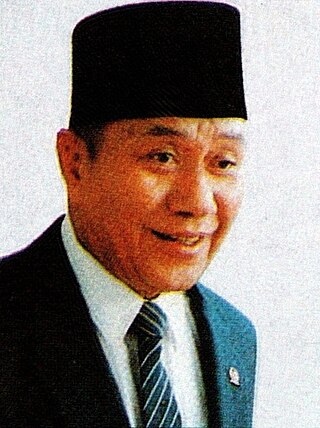
General (Ret.) Amir Machmud was an Indonesian military general who was an eyewitness to the signing of the Supersemar document transferring power from President Sukarno to General Suharto.

General Andi Mohammad Jusuf Amir, more commonly known as M. Jusuf, was an Indonesian military general and a witness to the signing of the Supersemar document transferring power from President Sukarno to General Suharto.

Major General (Ret) Basuki Rahmat was an Indonesian general, National Hero and a witness to the signing of the Supersemar document transferring power from President Sukarno to General Suharto.

The Second Revised Dwikora Cabinet was the Indonesian cabinet which served under President Sukarno from March 1966 until July 1966. The cabinet was formed after Lieutenant General Suharto, using the powers that Sukarno gave to him through Supersemar, arrested 15 ministers from the Revised Dwikora Cabinet who were suspected of being sympathizers of the Indonesian Communist Party (PKI).

The Revised Dwikora Cabinet was the Indonesian cabinet which served under President Sukarno from February 1966 to March 1966. The cabinet was formed under an extremely tense political situation, and it was expected that this cabinet would address the concerns of the people. It was during a meeting of this cabinet that unidentified troops surrounded the Presidential Palace causing to Sukarno to escape to Bogor from where he gave Supersemar to Lieutenant General Suharto.

Ali Murtopo was a prominent Indonesian general and political figure during the first half of General Suharto's New Order regime.
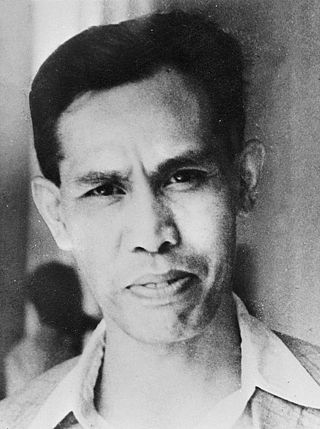
{{Leimena,is his Moluccan patronymic surname}}
The Operational Command for the Restoration of Security and Order, or Kopkamtib, was a military body established to deal with the 1965 coup attempt operation in Indonesia, and was subsequently used by President Suharto's New Order regime to suppress dissent.

The Fourth Working Cabinet was an Indonesian cabinet that resulted from regrouping of the previous cabinet by President Sukarno. It consisted of three deputy prime ministers, eight coordinating ministers, 33 ministers, six ministers of state, as well as 11 cabinet members who headed various government bodies. It was dissolved on 27 August 1964.

The Dwikora Cabinet was the 23rd Indonesian cabinet. President Sukarno reshuffled the previous cabinet on 27 August 1964 to produce a cabinet better able to implement the government policy he had announced in his Independence Day speech entitled "The Year of Living Dangerously". The cabinet was appointed on 2 September and served for a year and five months before being reshuffled on 21 February 1966.

Pengkhianatan G30S/PKI is a 1984 Indonesian docudrama co-written and directed by Arifin C. Noer, produced by G. Dwipayana, and starring Amoroso Katamsi, Umar Kayam, and Syubah Asa. Produced over a period of two years with a budget of Rp. 800 million, the film was sponsored by Suharto's New Order government. It was based on an official history of the 30 September Movement coup in 1965 written by Nugroho Notosusanto and Ismail Saleh, which depicted the coup as being orchestrated by the Communist Party of Indonesia.

Major General Pranoto Reksosamodra was an Indonesian Army general who was briefly army chief of staff and was detained for 15 years without trial for alleged involvement in the 30 September Movement coup attempt.






















